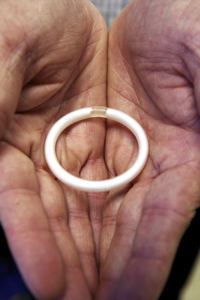 |
| Dr. Enrique Jacome |
To help women in their quest for better living, here are five resolutions to improve physical and mental well-being. If you've made attempts at sounder mind and body before, don't get discouraged. This is just another wonderful chance for you to make it happen:
New Year's Resolution No. 1: Eat, but Don't Pig Out
When women resolve to lose weight, they are often black and white about it, says Bonnie Taub-Dix, spokeswoman for the American Dietetic Association. She says women tend to want to cut out major food groups, telling themselves they cannot have any candy, dessert, or carbohydrates.
"It's a setup for failure, because by the time mid-January comes around, those resolutions are already in line for the next new year," says Taub-Dix. "It would be a much wiser decision to say, for example, 'I'm going to cut back on desserts.' Maybe pick a Saturday to have dessert." Instead of deprivation, practice moderation during the holidays.
The reduction approach is much more realistic than the all-or-nothing technique, which labels foods as "good" or "bad." When people see certain edibles as "bad," they can end up obsessing about it. Or they may see dieting as punishment for a year of unhealthy eating. Concentrate on getting adequate servings of whole grains, calcium, fiber, fruits and vegetables. This can be as easy as having a high-fiber cereal with milk and a banana.
Slashing entire food groups from the diet often backfires, because food is good and is one of the pleasures in life, says Taub-Dix. "There's no reason why we shouldn't enjoy food just because we're over the weight that we should be."
"Don't wait until the new year to have better eating habits, says Taub-Dix. "It should be a whole year's resolution, not a New Year's resolution."
New Year's Resolution No. 2: Jump Outside the Box
Many women who resolve to become more physically active think of going to the gym. They tend to hit the aerobic machines or join group exercise classes. They may get discouraged easily because they don't achieve desired weight loss or muscle tone in a certain time frame. They may quit because of lack of time, energy, or money. Or, they may tire of the gym atmosphere.
There are dozens of reasons why the best of workout intentions fall by the wayside come February. Yet they don't have to end up that way if you're willing to step outside of a certain mode of thinking -- that exercise has to be done a certain way, at a certain place, at a certain time, and for a certain amount of time.
"Sometimes people have this 'all or none' mentality and they're so gung-ho and so excited when they set the resolution that they judge themselves too harshly if they don't perfectly adhere to what they've established," says Cedric Bryant, PhD, chief exercise physiologist for the American Council on Exercise.
He says many people make resolutions that are either unrealistic or too vague. A woman, for instance, may resolve to lose 10 pounds in two weeks. If she doesn't see desired results, she becomes discouraged and gives up.
It's better to set fitness goals that are realistic, achievable, and well defined. For example, a woman may strive to lose one to two pounds per week by exercising three to four times per week and holding off on seconds at the dinner table.
While the trend is changing, too many women don't do valuable resistance training, says Bryant. According to the Mayo Clinic, enhanced muscle mass can not only help better manage weight, it can also improve endurance, maintain the flexibility of joints, and reverse age-related declines in strength, bone density, and muscle mass.
Even very busy women can do resistance training and aerobic exercise, as they do not necessarily require a visit to a fitness center. "If you can't get to the gym, what can you do today to be more active?" asks Saralyn Mark, MD, senior medical adviser for the Office on Women's Health in the U.S. Department of Health and Human Services. "Can it be walking a little bit further in the parking lot, and using the stairs, or raking your leaves?"
"There's a lot you can do with just what is around you," says Mark. "The best part is that you don't have to get into a fancy gym outfit. You can be comfortable and you can do it while you're watching the news."
New Year's Resolution No. 3: Guard Against the Bone Thief
"A lot of women feel that when they're not babies anymore, they don't have to worry about their bones, but it's quite the contrary," says Taub-Dix. "Watching calcium in your diet even as a young child or teen is very important, because that is the setup for what your bones may look like later on in life."
Osteoporosis, a bone-thinning disease, is major public health threat for 44 million Americans, 80% of whom are women, according to the National Institute of Health Osteoporosis and Related Bone Diseases. One out of every two women over 50 years old will have an osteoporosis-related fracture in her lifetime.
To help prevent osteoporosis, Taub-Dix suggests getting at least three servings of dairy a day. Healthy sources of dairy include skim milk, low-fat cheeses, and yogurt. There are also nondairy options for calcium, such as canned salmon with bones, dark green vegetables, dried beans, and calcium-fortified juices and cereals. Calcium supplements can also help women meet their recommended daily intake.
Adequate intakes of calcium for women:
- From age 11 to 24, between 1,200 and 1,500 milligrams daily
- From age 25 to 50, 1,000 milligrams daily
- For postmenopausal women 1,000-1,500 milligrams daily if on menopausal hormone therapy
- For pregnant and breastfeeding women, 1,200-1,500 milligrams daily
Women also should be aware that without vitamin D, calcium absorption is reduced. This vitamin is found in some foods sources including fatty fish, fish liver oil, and diary products that are fortified with vitamin D. An adequate intake of vitamin D for adults ranges from 200-600 international units a day.
Weight-bearing exercises, which use gravity to put pressure on the bones, can also help strengthen bones. Examples include walking, running, aerobics, and dancing. Resistance-training exercises are also valuable as they help enhance muscle mass and bone strength.
Be aware that certain foods and medications may help weaken bones. There is some evidence that soda drinking can contribute to bone loss, primarily because many soda drinkers tend not to drink milk. Research also shows nicotine can slow down bone cell production and cause faster bone loss.
"It's important that you talk with your doctor about how much calcium you get in your diet, whether you smoke cigarettes, your family history, whether you've been on Depo-Provera, or you've had a history of other diseases that have required you to be on steroids or thyroid medications," says Mark.
The FDA recently issued a strong warning about potential bone density loss with use of the contraceptive Depo-Provera. Use of steroids and an overactive thyroid have also been associated with weak and thinning bones.
New Year's Resolution No. 4: Take Health Exams and Get an "A" for Good Health
An osteoporosis screening test is ideal for all women aged 65 or older, or for younger women with one or more risk factor. It is also important to get tested if this problem runs in your family.
There are other important health exams for women, and the optimal benefits usually correspond with certain age groups. Mammograms, for example, screen for breast cancer, a disease with a risk that increases after age 40. Consequently, the Task Force recommends that mammograms be performed every one or two years beginning at 40.
Pap smears, which screen for cervical cancer, are recommended to start within three years of onset of sexual activity or at 21 years old, whichever comes first, and to continue screening at least every three years. Also, discuss with your doctor the new HPV vaccine, which helps reduce your risk of cervical cancer.
Starting at 50, testing for colorectal cancer is also important. The disease more often strikes older men and women.
Other important areas of screening for women include blood pressure, cholesterol, diabetes, depression, and sexually transmitted diseases.
There are risks to every exam, including the possibility of an inaccurate report. Overall, though, experts say they play an invaluable role in good health. "Screenings can't prevent anything, but they can make treatment more effective," says Cindy Pearson, executive director of the National Women's Health Network.
New Year's Resolution No. 5: Move Center Stage
Women are well-known caretakers and jugglers of several tasks at once. With responsibilities concerning home, work, and children, there just aren't enough hours to do all that needs done. The result: many women feel frazzled, frustrated, and forlorn.
The mere thought of taking time to take care of themselves sends ripples of guilt through many women. Where does one find the time for self-care?
Make the time, says Mark. Research shows stress can wreak havoc on health. It's not unusual for the stressed to have stomachaches, diarrhea, increased appetite, and weight gain. Constant stress can also compromise the immune system, making people more vulnerable to colds and other infections. The pressure can also aggravate illnesses, produce anxiety and depression, disrupt valuable sleep, decrease sex drive, and raise blood pressure.
The list of negative consequences goes on and on. But women do not have to be victims, or they can try to change unpleasant situations.
Peter A. Wish, PhD, a psychologist in Sarasota, Fla., suggests identifying stresses, prioritizing them according to importance, and then tackling them one at a time. He recommends starting with an easy objective, and then moving on to another minigoal. "It starts with something that you can be successful at, and nothing succeeds like success," he says. "It reinforces you to keep going."
If a woman is not able to accomplish everything on her list, Wish says not to fret. "The probability is that [women] won't be able to accomplish everything, and therefore, they shouldn't be too hard on themselves."
With the to-do list never ending, there's no better time than today to find time to do something for yourself, even if it's just for 10 minutes. The ideas vary with individual tastes, but some women have found doing simple things, such as walking, exercising, talking to a friend, soaking in the tub, or meditation to be highly enjoyable and relaxing.
So this new year, think of what's important to you, make your resolutions, and vow to make this the beginning of If a woman is not able to accomplish everything on her list, Wish says not to fret. "The probability is that [women] won't be able to accomplish everything, and therefore, they shouldn't be too hard on themselves."
With the to-do list never ending, there's no better time than today to find time to do something for yourself, even if it's just for 10 minutes. The ideas vary with individual tastes, but some women have found doing simple things, such as walking, exercising, talking to a friend, soaking in the tub, or meditation to be highly enjoyable and relaxing.



